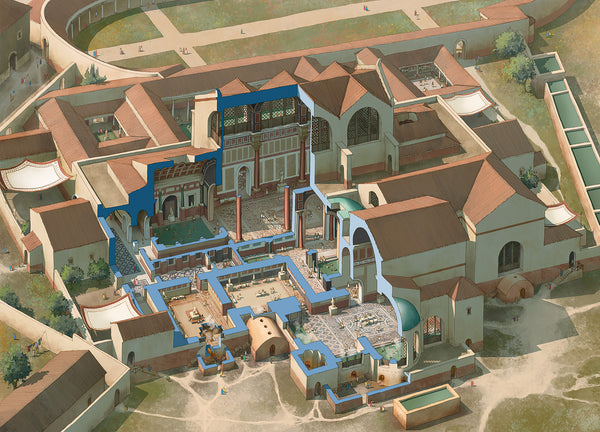Musing on Mesopotamia in the Magazine
By Owain Williams
Instead of the usual book review, reading recommendations, or interesting tidbits, today’s blog is a little look behind the scenes (or pages?) of the magazine. Specifically, as it is one of the most requested regions to be discussed in the magazine, after Greece and Rome, I am going to write about ancient Mesopotamia and the difficulties we face when putting together articles and themes on the history of the region.
We have had a few articles in recent issues covering topics from ancient Mesopotamia. In AH 46, Poppy Tushingham wrote about the importance of divination during the reign of Esarhaddon, ruler of the Neo-Assyrian Empire in the seventh century BC; Karwansaray Publishers’ Murray Dahm wrote about the findings from the Royal Cemetery of Ur in AH 50; and in AH 51, Tate Paulette wrote about beer in Mesopotamia and Henriette Broekema wrote about the famous ivories from Nineveh, the capital of the Assyrian Empire, known as the ‘Woman in the Window’. However, these articles are far outnumbered by articles on ancient Greece and Rome.

There is a simple reason for this disparity – ancient Greece and Rome are simply more popular topics, making finding authors able to dedicate enough time to write for the magazine difficult. Yet this is not the only reason, nor is it the most important reason. That is the relative dearth of appropriate imagery, particularly compared to ancient Greece and Rome. This is, in part, connected to the popularity issues. While archaeologists have been exploring the Near East since the late nineteenth century, the frequency and density of archaeological digs in Greece and Italy far outstrip anything there. There are certain ‘hot spots’ for artefacts with available imagery, such as the Royal Cemetery of Ur and the Assyrian palace at Nineveh, but these are rather atypical. Instead, many sites tend to reveal pottery sherds or inscribed clay tablets – important objects for the study of the site, but not suitable for illustrating a magazine. Consequently, topics that stray outside of the artefact-rich zones of Ur and Assyria, among others, tend to lack a comprehensive corpus of imagery from which we can draw from for our articles. Even topics within the artefact-rich zones have their own drawbacks, the most frustrating of which – from a magazine perspective – is the lack of what we call ‘anchor images’. These are larger images, sometimes frescoes or reliefs, but typically locations, and we try to include a wide selection of these different types per article. Regarding ancient Mesopotamia, however, outside of the reliefs from the Assyrian palaces, there are few such images, with locations, for example, tending to be little more than dusty stone (from an imagery perspective).
The availability of images of a suitable variety is something we must consider with all topics, periods, and places. It is a simple fact that some cultures and periods are better represented in the archaeological record than others, which translates over into better images for us to use. Unfortunately, fascinating and popular periods and places, such as Mesopotamia, are restricted by these considerations. Hopefully we have more Mesopotamia-centric articles in the future.
Do you have any ideas for articles? Let us know in the comments!


3 comments
Thanks for the great suggestions, Duncan!
Unfortunately, Neil, maps and other illustrations are only a partial solution for this issue. A map or illustration only replaces a fraction of the anchor images we need. Sadly, it is an issue we cannot ignore.
I’d say don’t let the lack of a good anchor image hold back an article exploring new themes and geographies. Perhaps a colourful and informative map and/or a piece of sketched art imagining how things were back in the ancient period would do the job nicely.
Thanks for raising this issue. There’s a lot more of ancient history than the last five centuries BCE in Italy and Greece. I don’t mind a bit of Classical scholarship, but I’d like it leavened with a broader view, bringing in strands from precursor and contemporary civilisations, as well as archaeological context. Otherwise we are likely to hear the same old tropes. I’ve been buying AHM from WH Smiths when I see something interesting, but I’d subscribe if there was more from this wider ancient world.
If you’re looking at written sources the literature is far broader in range than the Classics canon, which perhaps makes it harder work to draw out stories than reworking well-known sources. But there are plenty of stories out there to be told. If you’re looking at material culture the range of architecture and artistry is simply immense.
I haven’t been back over past issues with a fine toothcomb, but has there been a review of Stephanie Dalley’s book (quite old now) about the Hanging Gardens of Babylon? A good example of an intersection of Classical and Mesopotamian evidence.
Other examples of themes for the magazine that could/should include a healthy mix are:
Religion, belief, divination practices and mysticism – the weird and wonderful (illustrated with a variety of artefacts and sculpture from various places and times).
Diplomacy and administration – using classical commentaries and letters that people actually wrote to each other (illustrate with visuals from each of the cultures mentioned).